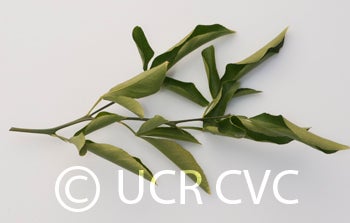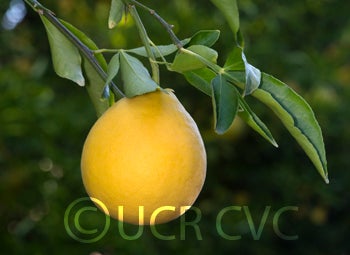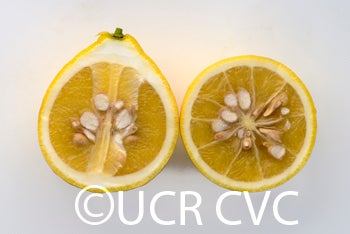X Citroncirus spp. RUTACEAE
CRC 3771
PI 539828
VI 356
Source
Received as budwood from USDCS, Indio, CA via CCPP, 1977.
Parentage/origins
'Duncan' grapefruit x Poncirus trifoliata
Rootstocks of accession
Carrizo citrange, C-35 citrange
Season of ripeness at Riverside
Unknown.
Notes and observations
RRK, 01/2008: This is definitely Swingle. USDA-DCS GH 316. Origin FF-9-22-55 Leesburg USDA Foundation Farm, Florida...(WP Bitters, 12/02/1979)
USDA Foundation Farm, Leesburg, Florida, Block 9, Row 22, Tree55. Is supposed to be clonal (budwood) source of CPB 4475. Per letter of J. Carpenter Feb. 8, 1974 to Carl Sierra, Calif. State Div. of Plant Industy. (RK Soost, 07/1985)
It certainly appears that there was some concern about getting the correct bud source of 'Swingle' back in the 1970s. Note: Referenced letter of JBC to CDFA is not on file to present knowledge.
There are currently three (apparently redundant) accessions of 'Swingle' maintained at the Repository: the current accession PI 539828/RCRC 3771, PI 539844/RCRC 3767, and PI 539824/RCRC 3341. Apparently PI 539844/RCRC 3767 and PI 539828/RCRC 3771 were received from the same source (USDCS) at slightly different times and were given different CRC numbers (which were assigned differently in the 1970s than they are now). It appears that PI 539844/RCRC 3767 was received about a year later than PI 539828/RCRC 3771 and was planted into the Citrus Variety Collection without any sort of indexing, or possibly it was indexed without receiving a VI number. In any case, it appears that PI 539844/RCRC 3767 and PI 539828/RCRC 3771 are the same genotype and derived from the same source and as such are definitely redundant.
Although 'Swingle' was originally hybridized by Swingle in 1907, experimentation with it as a rootstock did not begin until about four decades later. Trials were planted in Florida by personnel from the Subtropical Horticulture Laboratory in Orlando and in Texas by USDA personnel including Bill Cooper, Ed Olson, Heinz Wutscher. To Heinz Wutscher must go much of the credit for developing 'Swingle' into the widely used rootstock that it is today. The early development work is summarized in the Release Notice, Hutchison (1974), Anonymous (1974), Wutscher (1979), Castle (1987), and Castle et al (1988, 1989). These sources summarize the superior attributes of 'Swingle' as being resistant to tristeza and Phytophthora foot rot, blight, cold, and citrus nematode. However, in some cases, trees budded onto 'Swingle' that were infected with 'severe' strains of exocortis or cachexia remained stunted and produced a bud union crease. 'Swingle' is moderatlely salt tolerant but is not adapted to heavy clay soils or calcareous soils. 'Swingle' was observed to be particularly well adapted for use with grapefruits and in some cases 'Lisbon'-type lemons.
These attributes lead 'Swingle' to become the mostly highly utilized rootstock in Florida (Stover and Castle, 2003). However, as older trees on 'Swingle' became available to observe, some limitations became apparent (Castle and Stover, 2000; Stover and Castle, 2003; Castle and Stover, 2001). In addition to those noted above associated with soil conditions, trees on 'Swingle' were observed to decline decline on specific Flatwoods and Ridge soils and when Phytophthora was present in combination with Diaprepes; some apparent incompatibilities with specific scions also appeared. Nonetheless, 'Swingle' is considered one of the 'standard' rootstocks to be considered for planting in many situations or trials.
Availability
Commercially available in California through the Citrus Clonal Protection Program. Click here to order budwood.
USDA Germplasm Resources Information Network page for Swingle citrumelo trifoliate hybrid (CRC 3771)




